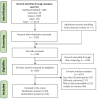Global morbidity and mortality of central nervous system tuberculosis: a systematic review and meta-analysis
- PMID: 35288778
- PMCID: PMC8920747
- DOI: 10.1007/s00415-022-11052-8
Global morbidity and mortality of central nervous system tuberculosis: a systematic review and meta-analysis
Abstract
Background: Tuberculosis (TB) is the second most common cause of death due to a single infectious agent worldwide after COVID-19. Up to 15% of the cases are extrapulmonary, and if it is located in the central nervous system (CNS-TB), it presents high morbidity and mortality. Still, the global epidemiology of CNS-TB remains unknown.
Aim: To estimate the global prevalence and incidence of CNS-TB based on the available literature.
Methods: We systematically searched in MEDLINE, Cochrane Central, Scopus, and LILACS databases (April 2020) and included observational studies evaluating the epidemiology of CNS-TB. Two independent researchers selected and assessed the quality of the studies and extracted relevant data. We performed random-effects model meta-analysis of proportions to estimate the pooled prevalence. The protocol of this study was registered in PROSPERO (CRD 42018103946).
Results: We included 53 studies from 28 countries, representing 12,621 patients with CNS-TB. The prevalence of CNS-TB was 2 per 100,000 inhabitants. According to the clinical setting, the prevalence of CNS-TB represented the 13.91% of all cases of meningitis and 4.55% of all cases of TB. The mortality was calculated by tuberculous meningitis due to the lack of data of other presentation, and it rose up to 42.12% in hospitalized patients. The burden of countries' TB, Human Development Index (HDI), and the prevalence of HIV were the most important prevalence moderators, especially in patients with TB. No data on incidence were found.
Conclusion: The prevalence and mortality of CNS-TB remain high, and TB meningitis is the most frequent presentation. The highest prevalence was reported in developing countries, and its main moderators were the countries' HDI and HIV infection. Our study was limited by high heterogeneity, risk of bias, and potential data under registration from developing countries. The integration of CNS-TB early detection and management into national TB programs and population-based studies from developing countries are needed for better global estimation and response.
Keywords: Central nervous system; Meningitis; Prevalence (SOURCE: MeSH-NLM); Tuberculoma; Tuberculosis.
© 2022. The Author(s), under exclusive licence to Springer-Verlag GmbH Germany.
Conflict of interest statement
The authors declare no conflicts of interest.
Figures




References
-
- Acevedo-Mendoza WF, Buitrago Gomez DP, Atehortua-Otero MA, Paez MA, Jimenez-Rincon M, Lagos-Grisales GJ, Rodriguez-Morales AJ. Influence of socio-economic inequality measured by the Gini coefficient on meningitis incidence caused by Mycobacterium tuberculosis and Haemophilus influenzae in Colombia, 2008–2011. Le infezioni in medicina : rivista periodica di eziologia, epidemiologia, diagnostica, clinica e terapia delle patologie infettive. 2017;25:8–12. - PubMed
-
- Alva-Díaz C, Navarro-Flores A, Rivera-Torrejon O, Huerta-Rosario A, Molina RA, Velásquez-Rimachi V, Morán-Mariños C, Farroñay C, Pacheco-Mendoza J, Metcalf T, Burneo JG, Pacheco-Barrios K. Prevalence and incidence of epilepsy in Latin America and the Caribbean: a systematic review and meta-analysis of population-based studies. Epilepsia. 2021;62:984–996. doi: 10.1111/epi.16850. - DOI - PubMed
-
- Bank W (2021) World Bank Country and Lending Groups—World Bank Data Help Desk.
Publication types
MeSH terms
LinkOut - more resources
Full Text Sources
Medical
Miscellaneous

